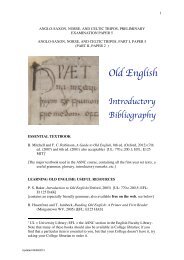Scandinavian history in the Viking age - Department of Anglo-Saxon ...
Scandinavian history in the Viking age - Department of Anglo-Saxon ...
Scandinavian history in the Viking age - Department of Anglo-Saxon ...
Create successful ePaper yourself
Turn your PDF publications into a flip-book with our unique Google optimized e-Paper software.
<strong>Scand<strong>in</strong>avian</strong> History <strong>in</strong> <strong>the</strong> Vik<strong>in</strong>g Age<br />
3859’, Y Cymmrodor 9 (1888), 141-83 (for text); J. Morris, Nennius: British <strong>history</strong> and <strong>the</strong> Welsh<br />
annals (1980), 44-49 (transl.), 85-91 (text) [UL 541:12.c.95.50]; also transl. A.W. Wade-Evans, Nennius’<br />
‘History <strong>of</strong> <strong>the</strong> Britons’ (1938), 84-101 [UL 179.c.27.36]<br />
Man<br />
[B148] The Man Chronicle has little <strong>of</strong> <strong>in</strong>dependent value until <strong>the</strong> mid-eleventh century. Text and<br />
transl.: P.A. Munch and Rev. Goss, Chronica regum Manniæ et <strong>in</strong>sularum: <strong>the</strong> Chronicle <strong>of</strong> Man and <strong>the</strong><br />
Sudreys, 2 vols, Manx Society 22-23 (1874) [UL Kk.5.22-23]; G. Broderick, Chronica regum Mannie et<br />
<strong>in</strong>sularum: Chronicles <strong>of</strong> <strong>the</strong> k<strong>in</strong>gs <strong>of</strong> Man and <strong>the</strong> isles (1979) [UL Ub.7.2037]<br />
Sagas and narratives<br />
Ireland<br />
For guidance, see (B122), ch. 9: ‘Eleventh- and twelfth-century histories and compilations’<br />
[B150] The Cogadh Gáedhel re Gallaibh ‘War <strong>of</strong> <strong>the</strong> Gaedhill [Gaels or Irish] aga<strong>in</strong>st <strong>the</strong> Gaill<br />
[Foreigners or Norse]’ was written around <strong>the</strong> first half <strong>of</strong> <strong>the</strong> twelfth century <strong>in</strong> <strong>the</strong> form <strong>of</strong> a historical<br />
saga, which heavily exaggerates <strong>the</strong> Vik<strong>in</strong>g <strong>in</strong>vasion <strong>of</strong> Ireland <strong>in</strong> order to enhance <strong>the</strong> reputation <strong>of</strong> high<br />
k<strong>in</strong>g Brian Boru <strong>in</strong> defeat<strong>in</strong>g <strong>the</strong>m; aside from <strong>the</strong> material <strong>in</strong>corporated from earlier annals, its historical<br />
value is slight. Text and transl.: J.H. Todd, Cogadh Gaedhel re Gallaibh: <strong>the</strong> war <strong>of</strong> <strong>the</strong> Gaedhil with <strong>the</strong><br />
Gaill, or The <strong>in</strong>vasions <strong>of</strong> Ireland by <strong>the</strong> Danes and o<strong>the</strong>r Norsemen, RS 48 (1867) [UL R542.30.48].<br />
Commentary: M. Ní Mhaonaigh, ‘Coe Gáedel re Gallaib: some dat<strong>in</strong>g considerations’, Peritia 9 (1995),<br />
354-77, and ‘Cogad Gáedel re Gallaib and <strong>the</strong> annals: a comparison’, Ériu 47 (1996), 101-26<br />
[B151] The saga <strong>of</strong> Cellachán <strong>of</strong> Cashel is a slightly later saga than <strong>the</strong> Cogadh (B150) with even less<br />
claim to any historical au<strong>the</strong>nticity. Text and transl.: A. Bugge, Caithreim Cellacha<strong>in</strong> Caisil, or The<br />
victorious career <strong>of</strong> Cellachan <strong>of</strong> Cashel, or The wars between <strong>the</strong> Irishmen and <strong>the</strong> Norsemen <strong>in</strong> <strong>the</strong><br />
middle <strong>of</strong> <strong>the</strong> 10th century (1905) [UL 593:01.b.1.71]. Commentary: D. Ó Corrá<strong>in</strong>, ‘Caithréim<br />
Chellachá<strong>in</strong> Chaisil: <strong>history</strong> or propaganda?’, Ériu 25 (1974), 1-69<br />
Wales<br />
[B155] Most mediaeval Welsh tales can safely be said to have little additional useful <strong>in</strong>formation on<br />
<strong>Scand<strong>in</strong>avian</strong> affairs; cf., for example, <strong>the</strong> bizarre accounts <strong>of</strong> <strong>the</strong> Norwegian k<strong>in</strong>gs <strong>in</strong> <strong>the</strong> genealogy <strong>of</strong><br />
Gruffudd ap Cynan, transl. D.S. Evans, A medieval pr<strong>in</strong>ce <strong>of</strong> Wales: <strong>the</strong> life <strong>of</strong> Gruffudd ap Cynan (1990)<br />
[UL 1992.8.2328], and cf. (E88)<br />
[B156] The Welsh Bruts conta<strong>in</strong> some <strong>in</strong>formation <strong>of</strong> value on <strong>the</strong> Vik<strong>in</strong>g <strong>age</strong>, most accessible through a<br />
series <strong>of</strong> texts and translations from T. Jones published <strong>in</strong> <strong>the</strong> <strong>history</strong> and law series by <strong>the</strong> Board <strong>of</strong><br />
Celtic studies: Brut y tywysogion or The chronicle <strong>of</strong> <strong>the</strong> pr<strong>in</strong>ces: Peniarth MS. 20 version, 6 (1941) and<br />
11 (1952) [UL 485:01.b.1.6, -.11]; Brut y tywysogion or The chronicle <strong>of</strong> <strong>the</strong> pr<strong>in</strong>ces: Red Book <strong>of</strong><br />
Hergest version, 16 (1955) [UL 485:01.b.1.16]; Brenh<strong>in</strong>edd y Saesson or The k<strong>in</strong>gs <strong>of</strong> <strong>the</strong> <strong>Saxon</strong>s, 25<br />
(1971) [UL 485:01.b.1.25]<br />
O<strong>the</strong>r sources<br />
[B160] Dicuil was an Irish monk (although work<strong>in</strong>g <strong>in</strong> a Carol<strong>in</strong>gian context), who <strong>in</strong> 825 completed a<br />
book on world geography; while heavily <strong>in</strong>debted to earlier, classical authorities, chapter 7 <strong>in</strong> particular<br />
conta<strong>in</strong>s <strong>in</strong>dependent observations on <strong>the</strong> North Atlantic. Text and transl.: J.J. Tierney and L. Bieler,<br />
Dicuili liber de mensura orbis terrae, Scriptores lat<strong>in</strong>i Hiberniae 6 (1967) [UL 716:01.b.1.6]<br />
Russian sources<br />
Russian written sources do not beg<strong>in</strong> to appear until <strong>the</strong> eleventh century, and <strong>the</strong>ir value for <strong>the</strong> early<br />
<strong>history</strong> <strong>of</strong> <strong>the</strong> Vik<strong>in</strong>gs <strong>in</strong> <strong>the</strong> East is doubtful. It is never<strong>the</strong>less important to remember <strong>the</strong> close<br />
connections between Scand<strong>in</strong>avia and Russia <strong>in</strong> <strong>the</strong> eleventh century, as well as <strong>the</strong> fact that <strong>the</strong> Russian<br />
‘state’ was develop<strong>in</strong>g at <strong>the</strong> same time as <strong>the</strong> k<strong>in</strong>gdoms <strong>of</strong> Scand<strong>in</strong>avia and <strong>of</strong>ten <strong>in</strong> similar ways; <strong>the</strong><br />
<strong>history</strong> <strong>of</strong> <strong>the</strong> pr<strong>in</strong>ces <strong>of</strong> Kiev can <strong>the</strong>refore be <strong>of</strong> great comparative <strong>in</strong>terest.<br />
17






